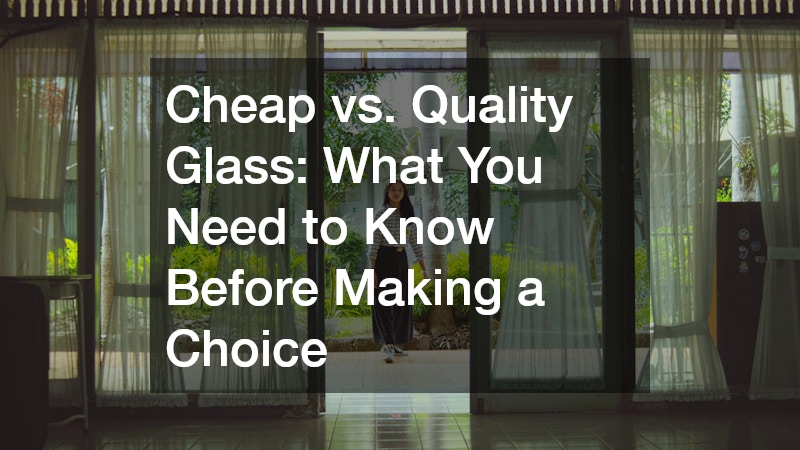Glass plays an important role in everyday life, from the windows in our homes and offices to the decorative elements in furniture and architecture. While it may seem like a simple material, the quality of glass can make a major difference in safety, durability, appearance, and performance. When comparing cheap versus quality glass, it is important to understand the differences and what those differences mean for long-term use.
Understand the Basics of Glass
At its core, glass is made by heating sand and other minerals until they melt, then cooling the mixture to form a solid, transparent surface. Though the basic recipe remains consistent, the quality of the raw materials, manufacturing process, and finishing techniques all affect the final product.
Cheap glass often comes from processes that prioritize speed and volume over precision. The result can be glass that looks similar to higher-quality options at first glance but lacks strength, clarity, and consistency. Quality glass, on the other hand, is manufactured with more care. From the selection of purer raw materials to advanced treatments such as tempering or lamination, quality glass is designed to perform better and last longer.
Consider Safety Features
One of the most important differences between cheap and quality glass is safety. In everyday use, accidents happen—windows can break, glass doors can shatter, and furniture can tip over. Cheap glass may break into large, sharp shards that can pose a serious risk. Quality glass, particularly tempered or laminated types, is engineered to reduce hazards.
Tempered glass, for example, is heat-treated to be stronger than standard glass. If it breaks, it crumbles into small, less dangerous pieces rather than sharp edges. Laminated glass includes a protective layer between glass panes, which keeps fragments in place even if the surface is damaged. These features make quality glass a better choice for areas where safety is a priority, such as doors, vehicle windshields, and children’s rooms.
Look at Durability and Longevity
Glass may seem like a fragile material, but high-quality glass is surprisingly durable. In fact, many architectural projects rely on glass for both structure and design because of its strength when produced correctly. Quality glass is less likely to chip, crack, or discolor over time, making it a more reliable option for long-term projects.
Cheap glass may be more prone to scratches and wear, especially in high-traffic or high-use areas. Over time, these small imperfections can build up, making the glass appear cloudy or worn. Durability is particularly important in applications like storefronts, tabletops, or shower enclosures, where frequent use demands a material that can withstand daily stress.
Evaluate Clarity and Appearance
The look of glass matters just as much as its performance. Quality glass is manufactured with better control over impurities, ensuring greater clarity and transparency. It allows more natural light to pass through, creating a brighter, more open environment. Architectural glass, for example, often uses low-iron formulations to minimize greenish tints and provide a cleaner appearance.
Cheap glass may show imperfections such as bubbles, streaks, or uneven thickness. These flaws may not always affect function, but they can diminish the overall aesthetic of a project. For design-focused spaces—whether in a home, office, or retail setting—choosing quality glass can elevate the entire look of the environment.
Think About Performance in Different Conditions
Glass is exposed to a wide range of conditions, from direct sunlight and humidity to sudden impacts and temperature changes. Quality glass is often treated to perform better under these circumstances. For example, coated or tinted glass can block harmful UV rays, reducing fading of interior furnishings. Insulated glass units can help maintain indoor comfort by improving energy efficiency.
Cheap glass may lack these features, leaving interiors more vulnerable to UV damage, drafts, and glare. Over time, this can affect not just the appearance of the glass itself but also the condition of the spaces it is meant to protect. Choosing quality glass ensures better performance across a variety of environments.
Rely on Reputable Glass Companies
When making decisions about glass, it is always best to work with reputable glass companies. These businesses often have a wide range of options and can guide you toward products that meet both practical and aesthetic needs. Established companies also tend to stand by the quality of their materials, offering warranties and support that give added peace of mind.
By contrast, lesser-known providers may offer glass that looks appealing at first but does not hold up under regular use. Trustworthy companies make it easier to balance design preferences, safety requirements, and performance standards.
The differences between cheap and quality glass go far beyond surface appearance. Safety, durability, clarity, and performance all depend on the type of glass you choose. While both options may seem similar at first glance, investing in quality glass provides long-lasting benefits that make it a smarter choice for most applications.
Whether you are planning a new construction project, replacing windows, or adding glass elements to your home or office, understanding the distinction between cheap and quality glass helps you make a more informed decision. By choosing carefully and working with reliable glass companies, you can ensure that your glass not only looks good but also performs well for years to come.

